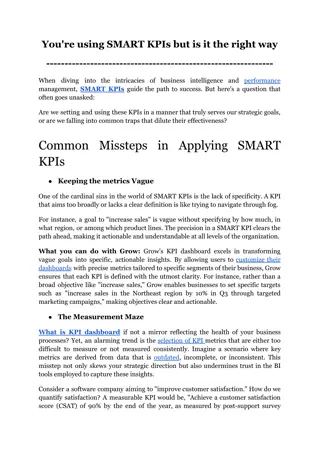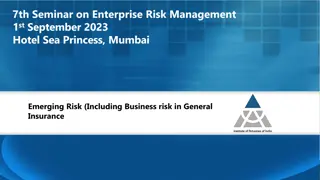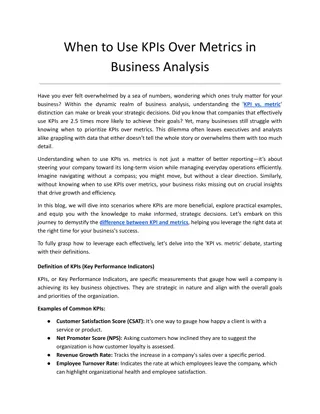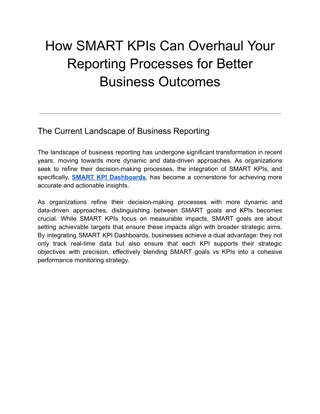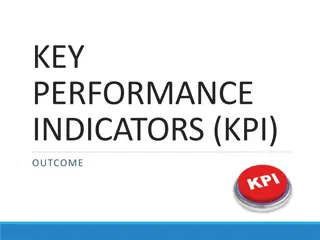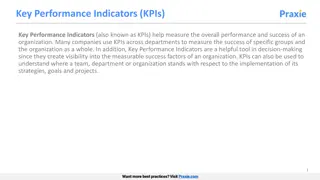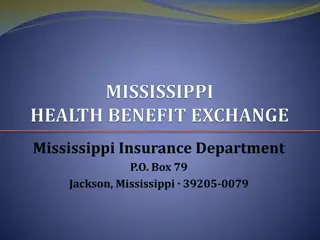Enhancing Risk Reporting and KPIs in Insurance Management
This content delves into improving attitudes towards risk and insurance in organizations, emphasizing the significance of setting effective Key Performance Indicators (KPIs) aligned with core business objectives. It provides insights on defining, compiling, and presenting KPIs for better risk and insurance management, supported by examples and principles to drive informed decision-making and strategic planning. The emphasis is on making data-driven decisions and enhancing risk awareness to elevate organizational performance and resilience.
Download Presentation

Please find below an Image/Link to download the presentation.
The content on the website is provided AS IS for your information and personal use only. It may not be sold, licensed, or shared on other websites without obtaining consent from the author.If you encounter any issues during the download, it is possible that the publisher has removed the file from their server.
You are allowed to download the files provided on this website for personal or commercial use, subject to the condition that they are used lawfully. All files are the property of their respective owners.
The content on the website is provided AS IS for your information and personal use only. It may not be sold, licensed, or shared on other websites without obtaining consent from the author.
E N D
Presentation Transcript
Improving the Reporting and Reward for Risk Some less enlightened attitudes to risk and insurance: Comment Resultant Key Performance Indicator (KPI) Target Our insurance is a cost, so we just need to minimise the premium? Reductions in insurance premium expenditure. You want me to spend how much money on improvements? I ve never had a claim in that area, it s not worth it. Minimise risk management funding where there are no short term losses. I only really care about what my competitors are doing in this area. Indemnity limit to be in the top quartile of selected peer group. Minimising the number of risk and compliance measures being escalated. That s just more internal reporting, I want to cut it back. I know we have claims but they re insured, that makes it a good deal for me to spend the premium. More claims!
Some Principles for Establishing KPIs Define what is important to your organisation, your boss, and your function. Link your KPIs to the core business objectives, for example: Organisational: revenue, profit, or costs. Boss: financial, legal, regulatory, social, ethical. Function: claims, costs, customer satisfaction, communication. Make them actionable by your audience. If you are unsure which KPIs to use try asking.
Compiling and Presenting KPIs Set your baseline numbers and decide how to capture and analyse the data Use analytics to get to the statistics you need. Present results in a clear and concise way at agreed intervals. Three KPIs is probably not enough but 12 is probably too many. Dashboard format provides a high level summary. Using graphics, charts, and Red, Amber, Green (R-A-G) ratings brings the numbers to life. Tell the underlying story. Include leading as well as lagging indicators. Include future targets. Individual risk KPIs are difficult and can be too slow.
Example Employers Liability Claims Many ways to tell a story Year Number Paid 480,000 470,000 580,000 636,000 648,000 434,000 363,000 290,000 25,000 20,000 Outstanding 150,000 425,000 500,000 Incurred 480,000 470,000 580,000 681,000 660,000 490,000 450,000 440,000 450,000 520,000 2008 2009 2010 2011 2012 2013 2014 2015 2016 2017 480 470 580 681 660 490 450 440 450 520 - - - 45,000 12,000 56,000 87,000 Source: Illustrative data
Dashboard Format Making reporting clear and concise aids executive buy-in Risk and Insurance KPI Dashboard - Q2 2018 INSURANCE PROGRAMME ECONOMIC COST KPI: ECOR less than 1% of Revenue M INDEMNITY LIMITS KPI: Limits to be at or above 1 in 200 year event level PROGRAMME ADMINISTRATION KPI: Final Policies within 30 days 16.00 14.00 Key Insurance Coverage Core Property Risk UK Flood California Earthquake Cyber Data Breach Cyber Business Interruption Public Liability Directors and Officers Liability Target Limit Actual Limit RAG Final Policy Issue Policy PDBI PL/Prods EL Motor PA Travel Cyber D&O 12.00 500 200 100 200 200 200 200 700 250 100 100 25 500 500 200 50 Days 22 34 5 1 28 40 10 10.00 0 Volatility Charge -100 -175 300 300 Taxes 8.00 Insurance Premium 6.00 Retained Losses 4.00 2.00 - 2013 2014 2015 2016 2017 RETAINED NATURAL CATASTROPHE RISK KPI: 1 in 100 year event to be less than 10% EBITDA EMPLOYERS LIABILITY CLAIMS COST PER EMPLOYEE KPI: Cost per Employee below 150. EMPLOYERS LIABILITY CLAIMS MANAGEMENT KPI: 75% of claims closed within 3 years 40 400 700 35 350 600 30 300 25 500 Earthquake 250 20 400 200 Wind Closed Claims 15 300 Open Claims 150 10 200 100 5 100 50 0 2008 2010 2012 2014 2016 Current 0 0 2008 2009 2010 2011 2012 2013 2014 2015 2016 2017 2012 2013 2014 2015 2016 2017 Source: Illustrative data
Examples of Existing KPIs A selection from a large and diverse population Risks Insurance Claims Governance Risk and Insurance Team Performance Service Provider Performance Risk register improvements (reducing frequency or severity) Total Cost of Risk reduction Reduction in claim numbers Compliance with risk reporting guidelines Customer Survey scores Broker administration and costs Reducing 1 in 200 year loss outcome Split in retained vs. transferred costs Target for overall claims costs Number of people being trained in risk management Number of internal publications Claims handler responsiveness Number of new risks identified Counterparty credit risk management compliance Accident rates No breaches of local tax and regulations Succession planning of key positions Document processing metrics Key risks reduced to as low as reasonably possible Premium savings Lost time incidents Retained insurable risks to be within group risk tolerance and appetite Business unit contact Policy issuance timings Proportion of contracts reviewed by risk team Coverage Top five claim causes identified and actioned Risks outside target parameters to be escalated in agreed timelines One and three year plan completed Reduction of administrative task time
Measuring Reductions in Uncertainty Risk is the effect of uncertainty on outcomes (ISO 31000) The value of insurance is reducing uncertainty to purchase or evaluate it without putting a price on that uncertainty is incomplete. Using sophisticated data and analytics we can now price uncertainty (volatility) which reveals the value of insurance. Setting insurance programme cost KPIs should include this element. Premium vs. Total Cost of Risk (TCOR) vs. Economic Cost of Risk (ECOR). Risk improvements can also be measured in this way.
KPIs for the Cost of Insurance Programmes The value of insurance is in the management of volatility Volatility of outcome Total Cost of Risk Economic Cost of Risk Full VALUE CREATION Insurance with reasonable deductible insurance, no retention Cost of Insurable Risk No insurance Expected retained losses Expected retained losses NO CURRENT PROGRAMME OPTION A OPTION B INSURANCE Illustrative, not to scale PREMIUM IMPLIED RISK CHARGE RETAINED LOSS Source: Illustrative data
Example KPIs Insurance Costs and Risk Control Improvements Insurance Programme Cost as % of Group Revenue Natural Catastrophe Exposure and EBITDA 10% EBITDA Source: Illustrative data EBITDA: Earnings before interest, taxes, depreciation, and amortization
What Good Looks Like Managing risk is managing uncertainty Link your KPIs to the performance of the core business. Make the KPIs relevant to specific audience members. Link them to actionable outcomes. Not too many, not too few, presented well. Make use of greatly improved data and analytics to analyse risk and measure how you are managing and reducing uncertainty. Then hit the targets!






